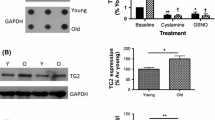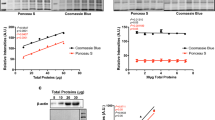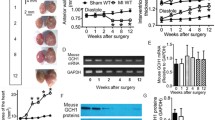Abstract
Some dipeptides have been implicated in myocardial protection, but little is known about their membrane transporter PEPT2. The aim of this study was to determine whether the expression and activity of the cardiac-type PEPT2 cotransporter could be affected by ageing and/or hypertension. Sarcolemmal vesicles (SV) were isolated from the hearts of all rat groups using a standard procedure to investigate the transport activity and protein abundance by fluorescence spectroscopy and Western blot, respectively. SLC15A2 “PEPT2” gene expression was relatively quantified by RT-qPCR. In the Wistar rat groups, the protein and gene expression of PEPT2 were upregulated with ageing. These changes were accompanied by corresponding increases in the competitive inhibition and the transport rate (Vmax) of β-Ala-Lys (AMCA) into SV isolated from middle-aged hearts. Although, the transport rate of β-Ala-Lys (AMCA) into SV isolated from old hearts was significantly the lowest compared to middle-aged and young adult hearts, the inhibition percentage of β-Ala-Lys (AMCA) transport by Gly-Gln was the highest. In the WKY and SHR rat groups, Y-SHR hypertrophied hearts showed an increase in PEPT2 gene expression accompanied by a significant decrease in protein expression and activity. With advanced age, however, M-SHR hypertrophied hearts revealed significantly lower gene expression, but higher protein expression and activity than Y-SHR hearts. These findings suggest that increased expression of PEPT2 cotransporter in all types of middle-aged hearts could be exploited to facilitate di-and tripeptide transport by PEPT2 in these hearts, which subsequently could result in improved myocardial protection in these populations.






Similar content being viewed by others
Availability of data and materials
Available on request.
References
Alghamdi OA, King N, Jones GL, Moens PDJ (2017) A new use of beta-Ala-Lys (AMCA) as a transport reporter for PEPT1 and PEPT2 in renal brush border membrane vesicles from the outer cortex and outer medulla. Biochim Biophys Acta 1860:960–964
Alghamdi OA, King N, Andronicos NM et al (2019) Molecular changes to the rat renal cotransporters PEPT1 and PEPT2 due to ageing. Mol Cell Biochem 452:71–82
Almashhadany A, Alghamdi OA, Van der Touw T, Jones GL, King N (2015) l-Glycyl-l-glutamine provides the isolated and perfused young and middle-aged rat heart protection against ischaemia-reperfusion injury. Amino Acids 47:1559–1565
Boengler K, Schulz R, Heusch G (2009) Loss of cardioprotection with ageing. Cardiovasc Res 83:247–261
Boll M, Herget M, Wagener M et al (1996) Expression cloning and functional characterization of the kidney cortex high-affinity proton-coupled peptide transporter. PNAS 93:284–289
Bustin SA, Benes V, Garson JA et al (2009) The MIQE guidelines: minimum information for publication of quantitative real-time PCR experiments. Clin Chem 55:611–622
Cabiati M, Raucci S, Caselli C, Guzzardi MA, D’Amico A, Prescimone T, Del Ry S (2012) Tissue-specific selection of stable reference genes for real-time PCR normalization in an obese rat model. J Mol Endocrinol 48:251–260
Cui X, Zhou J, Qiu J, Johnson MR, Mrug M (2009) Validation of endogenous internal real-time PCR controls in renal tissues. Am J Nephrol 30:413–417
Daniel H, Kottra G (2004) The proton oligopeptide cotransporter family SLC15 in physiology and pharmacology. Pflüg Arch 447:610–618
Frey IM, Rubio-Aliaga I, Klempt M, Wolf E, Daniel H (2006) Phenotype analysis of mice deficient in the peptide transporter PEPT2 in response to alterations in dietary protein intake. Pflüg Arch 452:300–306
Greiser KH, Kluttig A, Schumann B et al (2005) Cardiovascular disease, risk factors and heart rate variability in the elderly general population: design and objectives of the CARdiovascular disease, Living and Ageing in Halle (CARLA) Study. BMC Cardiovasc Disord 5:33
Jahangir A, Sagar S, Terzic A (2007) Aging and cardioprotection. J Appl Physiol 103:2120–2128
Jiang L, Qin X, Zhong X et al (2011) Glycine-induced cytoprotection is mediated by ERK1/2 and AKT in renal cells with ATP depletion. Eur J Cell Biol 90:333–341
King N, Williams H, McGivan JD, Suleiman M-S (2001) Characteristics of l-aspartate transport and expression of EAAC-1 in sarcolemmal vesicles and isolated cells from rat heart. Cardiovasc Res 52:84–94
King N, Lin H, McGivan JD, Suleiman M-S (2004) Aspartate transporter expression and activity in hypertrophic rat heart and ischaemia–reperfusion injury. J Physiol 556:849–858
King N, Lin H, McGivan JD, Suleiman M-S (2006) Expression and activity of the glutamate transporter EAAT2 in cardiac hypertrophy: implications for ischaemia reperfusion injury. Pflüg Arch 452:674–682
Kohler H, Ruggeberg J, Langer K et al (2000) Glycyl-glutamine improves in vitro lymphocyte proliferation in AIDS patients. Eur J Med Res 5:263–267
Kurata H, Fujii T, Tsutsui H et al (2006) Renoprotective effects of l-carnosine on ischemia/reperfusion-induced renal injury in rats. J Pharmacol Exp Ther 319:640–647
Li G-H, Le G-W, Shi Y-H, Shrestha S (2004) Angiotensin I–converting enzyme inhibitory peptides derived from food proteins and their physiological and pharmacological effects. Nutr Res 24:469–486
Lin H, King N (2007) Demonstration of functional dipeptide transport with expression of PEPT2 in guinea pig cardiomyocytes. Pflüg Arch 453:915–922
Liu J, Marchase RB, Chatham JC (2007) Glutamine-induced protection of isolated rat heart from ischemia/reperfusion injury is mediated via the hexosamine biosynthesis pathway and increased protein O-GlcNAc levels. J Mol Cell Cardiol 42:177–185
McCarty MF, DiNicolantonio JJ (2014) β-Alanine and orotate as supplements for cardiac protection. Open Heart 1:e000119
Nadtochiy SM, Burwell LS, Ingraham CA et al (2009) In vivo cardioprotection by S-nitroso-2-mercaptopropionyl glycine. J Mol Cell Cardiol 46:960–968
Nagai K, Tanida M, Niijima A et al (2012) Role of l-carnosine in the control of blood glucose, blood pressure, thermogenesis, and lipolysis by autonomic nerves in rats: involvement of the circadian clock and histamine. Amino Acids 43:97–109
Rubio-Aliaga I, Daniel H (2008) Peptide transporters and their roles in physiological processes and drug disposition. Xenobiotica 38:1022–1042
Seal CJ, Parker DS (1991) Isolation and characterization of circulating low molecular weight peptides in steer, sheep and rat portal and peripheral blood. Comp Biochem Physiol B 99:679–685
Sengupta P (2013) The laboratory rat: relating its age with human’s. Int J Prev Med 4:624–630
Smith DE, Clemencon B, Hediger MA (2013) Proton-coupled oligopeptide transporter family SLC15: physiological, pharmacological and pathological implications. Mol Asp Med 34:323–336
Zhang Y, Yan H, Lv SG et al (2013) Effects of glycyl-glutamine dipeptide supplementation on myocardial damage and cardiac function in rats after severe burn injury. Int J Clin Exp Pathol 6:821–830
Acknowledgements
This work was funded by the University of Jeddah and the University of New England. We would also like to thank the technicians for their excellent assistance.
Funding
This work was supported by the University of Jeddah and the University of New England.
Author information
Authors and Affiliations
Corresponding author
Ethics declarations
Conflict of interest
The authors have nothing to declare.
Ethical approval
This study was approved by the Animal Ethics committee of the University of New England and complies with the Guide for the care and use of laboratory Animals published by the US National Institute of Health (NIH Publication No. 85-23, revised 1996).
Additional information
Handling Editor: E. Closs.
Publisher's Note
Springer Nature remains neutral with regard to jurisdictional claims in published maps and institutional affiliations.
Rights and permissions
About this article
Cite this article
Alghamdi, O., King, N., Jones, G.L. et al. Effect of ageing and hypertension on the expression and activity of PEPT2 in normal and hypertrophic hearts. Amino Acids 53, 183–193 (2021). https://doi.org/10.1007/s00726-020-02936-y
Received:
Accepted:
Published:
Issue Date:
DOI: https://doi.org/10.1007/s00726-020-02936-y




